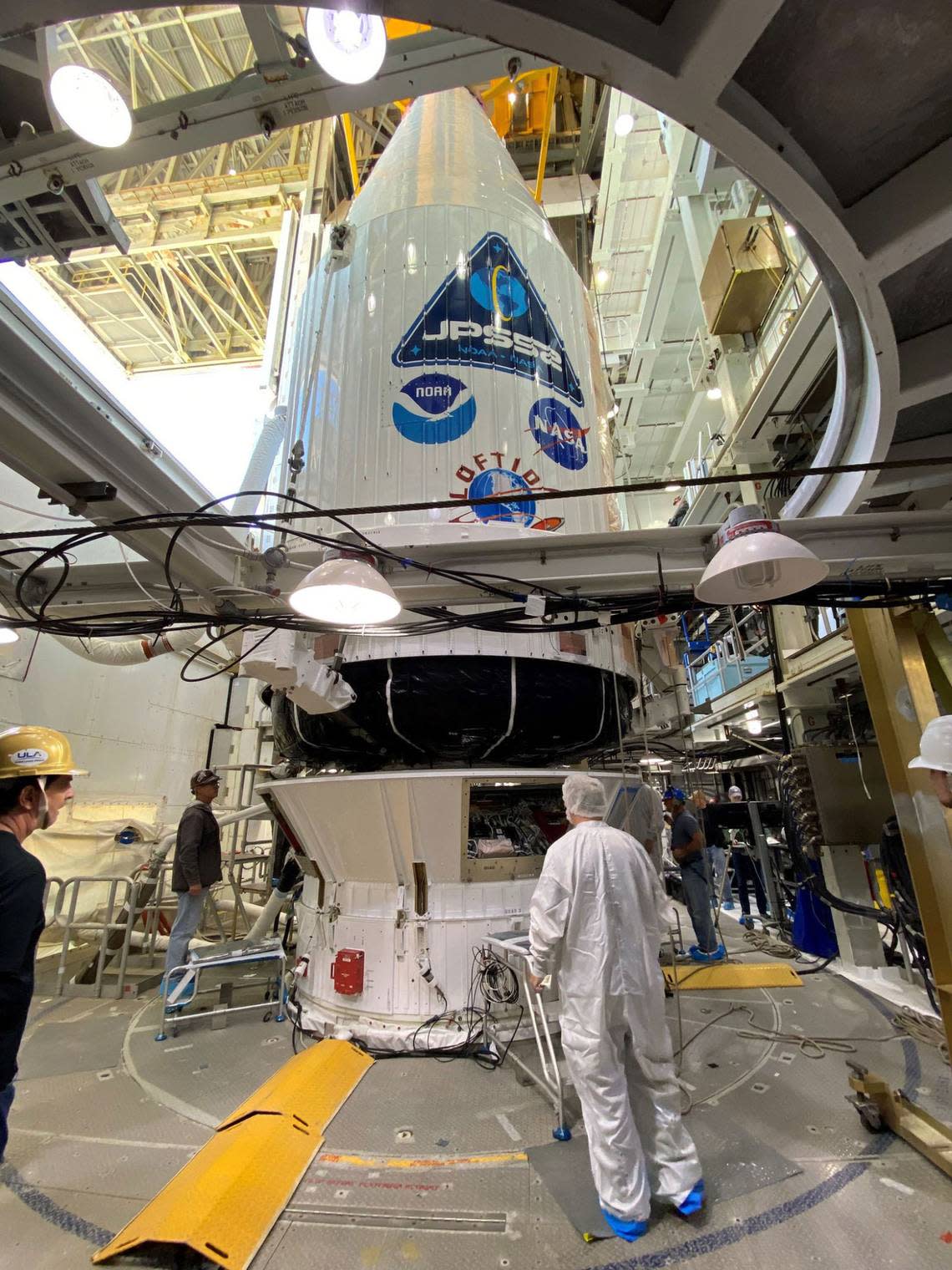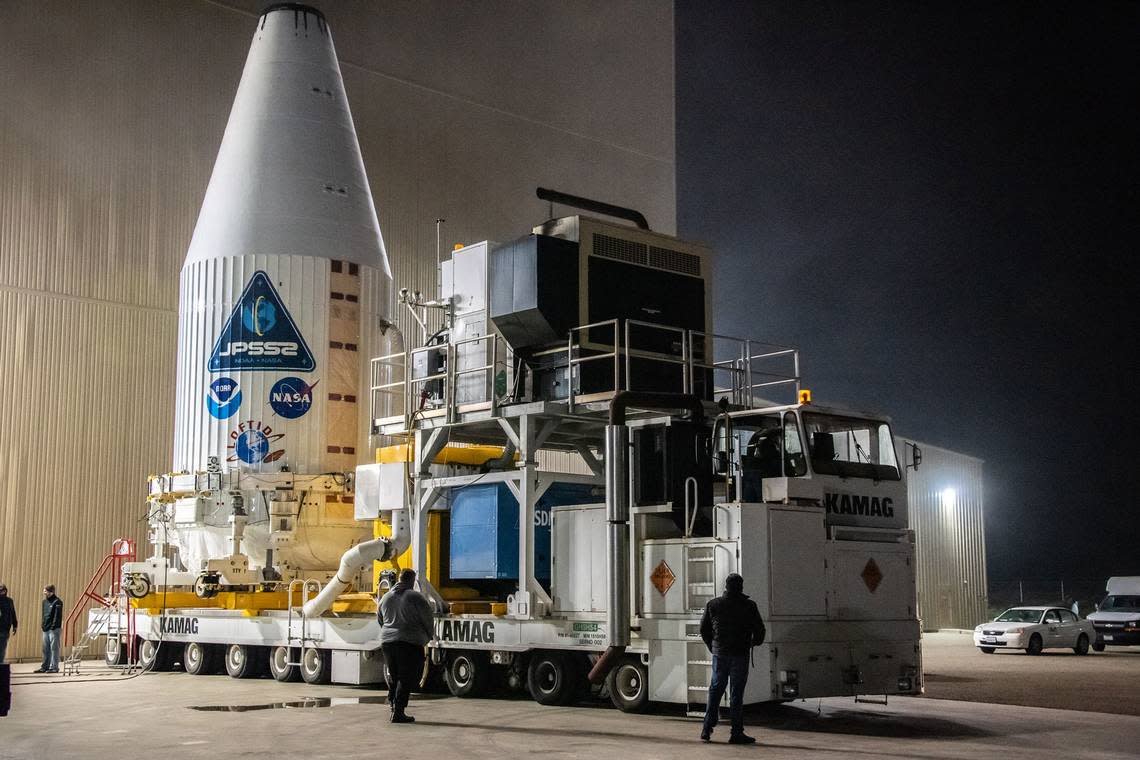Vandenberg readies for West Coast’s last Atlas V rocket launch — and the end of an era
After more than six decades and multiple versions performing various missions, the West Coast’s last Atlas V rocket will fly from Vandenberg Space Force Base this week on a mission to place an advanced weather satellite and a technology demonstrator in orbit.
Liftoff of the 191-foot-tall rocket built by United Launch Alliance will aim for 1:25 a.m. Thursday from Space Launch Complex-3, which can be viewed as the large structure with its mobile service tower on South Base near Lompoc.
The launch window remains open for 36 minutes, officials have said.
Weather forecasters say conditions will pose only a 10% chance of violating launch rules, with cumulus clouds being the concern.
A battery issue on the Centaur upper stage delayed the rocket’s planned Nov. 1 departure for more than a week.
The final Atlas V rocket launch will occur weeks after the West Coast’s last Delta IV rocket carried a top-secret payload into space.

“It’s been a busy few weeks here at Vandenberg,” said Gary Wentz, ULA’s vice president of government and commercial programs.
“The whole team here from United Launch Alliance is excited to be a part of this mission,” he said, noting the two critical payloads awaiting the trip.
Atlas will deliver the next in the series of weather satellites, the Joint Polar Satellite System or JPSS-2, for the National Oceanic and Atmospheric Administration (NOAA).
“Against the backdrop of the deadly destruction of Hurricane Ian in late September and Hurricane Ida in 2021, along with the destructive wildfires here in the West and in Alaska, NOAA’s weather satellites have never been more critical as extreme weather events continue to be more frequent because of climate change,” said Irene Parker, deputy assistant administrator, NOAA Systems, National Environmental Satellite, Data, and Services.
Also hitching a ride will be NASA’s and ULA’s Low-Earth Orbit Flight Test of an Inflatable Decelerator, or LOFTID to demonstrate potential technology for re-entry. The flight test for heat shield technology could be used for a future Mars mission or returning a component from a low-Earth orbit mission.

This is ULA’s 39th and final mission involving a critical and historical spacecraft spanning 16 years for NASA Launch Services Program, Wentz said.
“We’re looking forward to future business on Vulcan on both the East and West coasts,” Wentz said.
Vulcan will be ULA’s next generation rocket using the best parts of Atlas V and Delta IV, along with American-made engines, ULA officials said in a 2015 announcement.
“Super excited to be here, super excited to be launching the last Atlas V from the West Coast, enabling ULA to have some huge capability out of here with their Vulcan vehicle,” said Omar Baez, NASA’s senior launch director, who will retire after the launch.
The rocket’s departure will signal a new phase of work for the ULA team, according to Wentz.
“After this launch, our team will phase into the modifications to convert SLC-3 to be able to launch the Vulcan Centaur from the West Coast,” Wentz said.
The first-ever Atlas launch from Vandenberg occurred Sept. 9, 1959.
Atlas V debuted at Vandenberg in March 2008 with a total of 16 missions through 2021 to carry various military and civilian missions into space.
Before that, Atlas IIAS rocket debuted in December 1999 with the Terra satellite, the flagship of an Earth-observation system series of craft designed to give the planet a checkup.
Earlier Atlas space missions involved retired missiles, known as the Atlas E and Atlas F series, repurposed to carry satellites into space, and responsible for putting both military and civilian weather craft in orbit.
Over the years, Atlas rockets have carried ongoing key Earth-observation missions plus Vandenberg’s first interplanetary mission, the Mars Insight lander.
A broadcast of the launch will be available by NASA’s television channel and website. There will be live updates of key countdown milestones on ULA’s website.
Noozhawk North County editor Janene Scully can be reached at jscully@noozhawk.com . Follow Noozhawk on Twitter: @noozhawk , @NoozhawkNews and @NoozhawkBiz . Connect with Noozhawk on Facebook .
